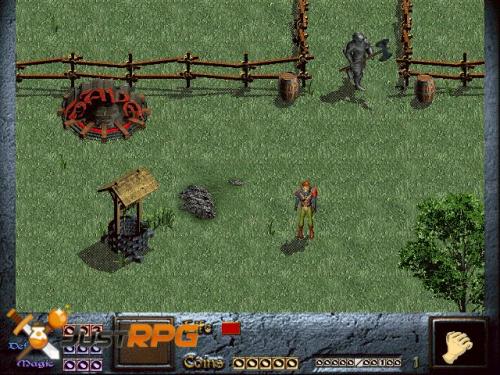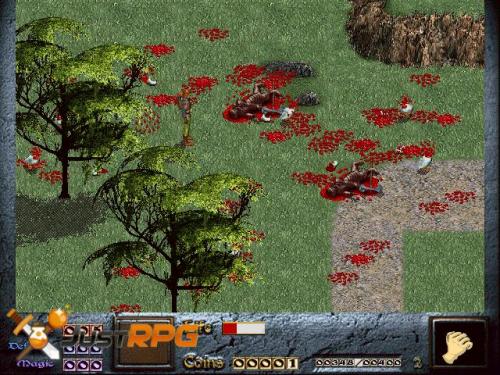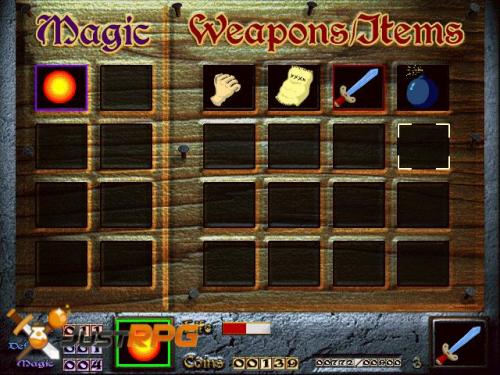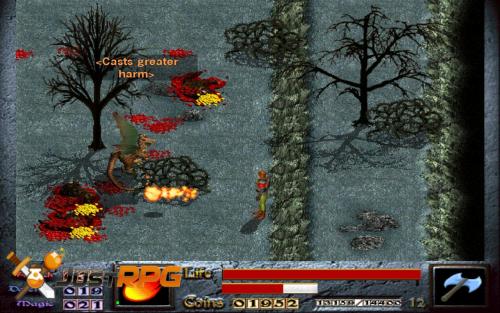Dink Smallwood
Dink Smallwood is an indie developed RPG with Zelda like gameplay. The satirical story follows Dink, a big farmer who must defeat a mysterious cult. After its initial release, Dink Smallwood was made available for free. It continues to be a popular free indie title that’s still supported by fan-made add-ons. A mobile version was released years later.
| Developer: Robinson Technologies Publisher: Iridon Interactive Release Date: 1997 Platforms: PC, iOS, Android JustRPG Score: 85% Pros: +Available as Freeware. +Light hearted story with plenty of humorous dialogue +Action oriented combat with a good mix of RPG elements. +Map editor and plenty of fan-made content. Cons: -Dated graphics and interface. -Limited replay value besides fan-made content. -Graphical glitches, limited save locations in some versions. |
Dink Smallwood Overview
Dink Smallwood is a RPG with action oriented, Zelda style combat. Developed by an indie studio, the game has simple isometric graphics but is available for free. First released in 1997, Dink Smallwood continues to attract attention from classic RPG fans for its quirky original story and level editor which has allowed players to create new content. Players start out as Dirk, a disgruntled pig farmer whose house burns down. The story is off-beat with plenty of humorous dialogue. The original story is entertaining, but a level editor allows enthusiasts to create their own content. In 2010 a mobile version of Dink Smallwood was released for the Apple iOS and Android operating system. Dink Smallwood continues to have a cult following even after 10+ years since its release.
Dink Smallwood Screenshots
Dink Smallwood Featured Video
[youtube]http://www.youtube.com/watch?v=F2Z-0izEXVc[/youtube]
Dink Smallwood Review
By, Payal Dhar
Perhaps the most endearing quality about Dink Smallwood – and there is more than one – is that it mirrors what we basically seek in life: Even though most of us start off small, we do want the world to sit up and take notice. However, if you are getting the idea that Dink has goody-goody philosophical undertones, you’re barking up an entirely wrong tree. Released in 1998 by RTSoft, it is now free to download and a candidate for the classic RPG list.
Take a spoonful of Zelda, add a dash of Monkey Island and a pinch of Diablo, and you have Dink Smallwood. While it wasn’t a runaway success, they did sell all their copies. The development team, which consisted of of Seth Robinson, Justin Martin, and Greg Smith, weren’t interested in publishing any more, so in 1999 – 17 October, to be exact – it was released as freeware. The free version also included Dink Edit for players to make their own modules and continue enjoying Dink’s adventures once they were done with the original game.
The story line is simple though fascinating. You must get into the skin of Dink Smallwood, a young lad helping his mother look after their pig farm. Dink, with slightly vulgar sense of humour, is thrown into the unlikely mold of an adventurer when an accident leaves him homeless and orphaned. Haunted by his hometown nemesis Milder Flatstomp, who insists on showing him up and making fun of his background, Dink must battle the odds and become a hero.
Dink sets out from his village of Stoneybrook to live with his aunt and uncle in Terris, but things turn out a bit more exciting than he anticipated. Along the way he meets a few people and plenty of monsters. He picks up quests, which basically consist of killing monsters and other bad guys, and gets laughed at for his swine-related background. As he proceeds he gets ample opportunity to increase his skill as a warrior.
The quests vary from something as inane as finding a lost duck and collecting nuts from the forest to rescuing a little girl from a sadistic ritual and saving a starving town. A sinister organization called the Cast seem to be the bane of the Dink universe, and most ‘bad’ things seem to be related to them. The quests must be completed in a linear fashion, unfortunately. So if you get stuck at one point, the chances are you are stuck for good. But if you are sharp and use your skills well, who knows, even the king might agree to see you and give you a special quest.
Monsters come in many shapes and sizes. You will come across gross boncas, bony shape-shifters, overweight-caterpillar-like things, a dragon or two, and even some belligerent ducks, among others. Of course, killing them gets Dink points and these points add up to increase his level. At each level increase, you get the option to beef up Dink’s Attack, Defense or Magic skills. In addition, you also come across gold and potions from monsters and treasure chests along the way. The gold is important, as you need to painstakingly save up to buy your weapons and elixirs. A word of warning: monsters keep re-spawning. However, there is a plus side. By killing them again and again, you get points and treasure all over.
Along the way Dink must interact with a number of non-playing characters (NPCs). What makes the game interesting is the choice you get in determining the line of the conversation. The space bar gets you a list of topics you can converse about. The right choice puts you in the way of a quest; the wrong one could lead to a meaningless dialogue punctuated with juvenile humour. There is no audio as far as conversations go. You must read off the screen, which is slightly annoying given the number of typos.
The NPCs go a long way in making the game a delight. Starting with a duck with attitude and Libby, a girl in Dink’s village for whom he has the hots (though he ends up hitting on almost anything female as he goes along), Dink meets all sorts of other characters. There is the abusive Uncle Jack, some interesting giant bookmaker ducks who let Dink bet on duck fights, goblins who are not too well-endowed in the ‘upper storey’, and of course a surprise final boss ‘monster’ to end the game with.
Movement and interaction is simple, and keyboard based. The arrow keys move Dink about on the screen, up, down, as well as diagonal. To pick up something, just make Dink walk through it. Apart from gold and elixirs that Dink picks up, each town he goes to has a shop or two that will sell things or buy stuff from him at ridiculously low prices. Most of Dink’s money is spent on weapons. Swords, bows, and bombs are there for the taking if he can afford them. You come across better and better – and more expensive – weapons progressively. If he can’t afford any weapons, as is the case initially, Dink can use his fists.
Weapons aside, the Herb Boots are a quaint acquisition. They make Dink walk faster and kick harder and faster, too. When he stands still with the Boots on, it looks like he’s dancing! Dink can also learn spells. This depends on his Magic level, though. While he gets fireball quite early, acid rain needs considerably higher skill. The Herb Boots and magic combination is quite potent. It helps Dink move considerably faster than most monsters and, keeping well out of their way, he can chuck magic to wear them down. Good news for the impatient types: to release pent-up frustration, you may kick furniture, ducks, and also the NPCs – with or without the Boots. However, when I felt it was time to teach Uncle Jack a lesson, I found those Herb Boots really useful!
The graphics are nothing to write home about when you compare them with other games of the same time. The human figures are a bit of a joke, and many of the animations repetitive. People also have the annoying appearance of gliding ethereally through the landscape. The music, however, is nice. It does grow on you, and the increased tempo when something interesting happens adds to the excitement.
It would have been nice to be able to save the game anywhere, but unfortunately you can do so only at special Save points. The other drawback is that, fascinating though unraveling the story is, Dink’s main job is just: kill monster, pick up gold and move on for more of the same. The time when you need to use your brains most is to allot points to Attack, Defense or Magic. The typos in the conversations are annoying, and some people might find the humour slightly trying, too.
The replay value of the game is virtually nil once you play it through. However, the D-MODs allow players to build their own mods. Of course, it may not be everyone’s cup of tea, but there are plenty of D-MODS available for download from the Web.
If you are interested in RPGs, Dink Smallwood is not one you can ignore. It’s addictive and its fascinating, without having the slickness of, say, Diablo. It’s just over 10MB to download, and needs a mere 32MB RAM to play. While free to download, here in Delhi you can still see the CD being sold for Rs 250 (US$ 6 approx.). Mac users, sorry, this is for Windows only.
Download it this evening, and I’ll wager that you shake your head and think, ‘What’s so great about this?’ for the first quarter of an hour you play it. Then it’ll be time to go to work.
Dink Smallwood Videos
Dink Smallwood Official Trailer
[youtube]http://www.youtube.com/watch?v=F2Z-0izEXVc[/youtube]
















